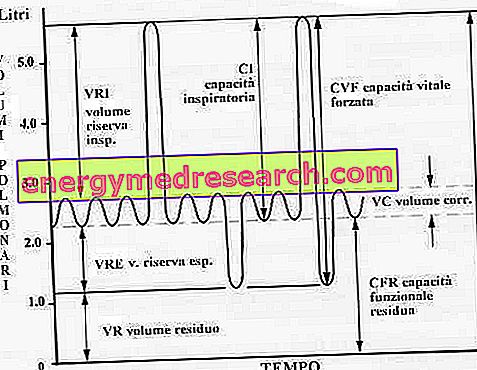Spirometry is the most common test for assessing lung function. It is a particularly effective and widespread diagnostic tool as it is standardized, painless, easily reproducible and objective.
Spirometry is frequently used in the diagnosis and evaluation of lung function in people with restrictive or obstructive airway diseases.
During the examination, a special instrument called a spirometer is used, which is able to evaluate the different lung volumes.
SPIROMETRY and static lung volumes | |||||||||||||||||||||||||||||
 SPIROMETRIC TRACK: thanks to the spirometer it is possible to measure the volume changes of the respiratory system. After having made the patient perform a rough inhalation that is not abrupt, expel all the air with a slow maneuver. | |||||||||||||||||||||||||||||
| LUNG VOLUME | DEFINITION | Average values, mL | |||||||||||||||||||||||||||
| men | females | ||||||||||||||||||||||||||||
| Current Volume (VC or TV) | Amount of air that is mobilized in a breath | 600 | 500 | ||||||||||||||||||||||||||
| Minute ventilation (VE): | Volume Current x Respiratory Rate (number of breaths per minute) | 7200 | 6000 | ||||||||||||||||||||||||||
| Expiration Reserve Volume (VRE or ERV) | Maximum expirable volume from the end of normal inhalation | 1200 | 800 | ||||||||||||||||||||||||||
| Inspiratory reserve volume (VRI or IRV) | Maximum inspirable volume from the end of normal inspiration | 3000 | 1900 | ||||||||||||||||||||||||||
| Residual Volume (VR) | air remaining in the lung at the end of a maximal exhalation | 1200 | 1000 | ||||||||||||||||||||||||||
| Vital Capacity (CV) or Forced vital capacity (CVF or FVC) | maximum amount of air mobilized in a maximal respiratory act | 4800 | 3200 | ||||||||||||||||||||||||||
| Forced vital capacity (FVC forced vital capcity). Total volume of air expelled in a forced expiration starting from a maximal inspiration, or vice versa. | 4800 | 3200 | |||||||||||||||||||||||||||
| Total Lung Capacity (CPT or TLC total long capcity) | = CV + VR = maximum amount of air contained in the lung (volume present in the lungs after maximal inspiration) | 6000 | 4200 | ||||||||||||||||||||||||||
| Functional residual capacity (CFR or FRC) | Volume present in the lungs at the end of normal breathing (measurable through a plethysmograph) | 2400 | 1800 | ||||||||||||||||||||||||||
| Inspiratory capacity | Maximum inspired volume starting from the normal end expiratory volume | 3600 | 2400 | ||||||||||||||||||||||||||
NOTE: During a physical exercise the tidal volume increases considerably, drawing on both the inspiratory reserve volume and the expiratory reserve volume. During a strenuous exercise the respiratory rate can go from 12 acts that are normally recorded in resting conditions to 35-45 cycles / min. Lung volumes vary according to age, sex and especially in relation to height and body size. High values of vital capacity are not uncommon in large subjects. A value of 8.1 liters was measured in an Olympic gold medal cross-country skier. As the age passes, the residual volume tends to increase, while the inspiratory and expiratory reserve volumes are reduced. Higher than normal lung capacity does not increase performance. It has been shown that even during a maximal exercise there is a functional reserve by the respiratory system equal to 15-35%. Therefore, in a healthy subject there is no limitation of respiratory performance even though this may not be completely true in the two extreme cases, ie for the sedentary and for the very high level middle distance runner SPIROMETRY, the forced expiration curve and the measurement of dynamic values | |||||||||||||||||||||||||||||
 Subsequently the subject is invited to perform a maximal inspiration (up to CPT), followed by a rapid, decisive and complete exhalation (up to VR). The patient's collaboration during spirometry is therefore essential. Technical requirements for good spirometry: Obtain at least three acceptable spirograms (VEMS and FVC must not differ more than 200 ml or 5%) Complete inspiration before the test Satisfactory start of exhalation (maximum effort, no hesitation) Absence of cough during the first second Adequate duration of the test (expiration lasting no less than 6 seconds or 15 seconds in case of bronchial obstruction) Perfect tightness and patency of the mouthpiece (the patient must be invited to tighten the spirometer mouthpiece firmly between the lips in order to avoid leaks). CONTRAINDICATIONS TO SPIROMETRY
It is possible to represent the forced expiration maneuver with a flow-volume curve: at each instant the instantaneous flow (ordinate) and the exhaled volume (abscissa) are reported.  Flow-volume curve derived from the recording in succession of a vital capacity forced in inspiration and expiration | |||||||||||||||||||||||||||||
| Maximum expiratory volume in the 1st second (VEMS or FEV1) | Expiratory air volume in the first second of a forced expiration, starting from a complete inspiration (forced expiratory volume in 1 s); it allows to measure the emptying speed of the lungs | ||||||||||||||||||||||||||||
| VEMS / CVF (Tiffenau Index) or FEV1 / FVC or | The relationship between VEMS and CVF is fundamental to discriminate an obstructive deficit from a restrictive one. It should be evaluated in terms of percentage on the theoretical (ex: FEV1 of 0.5 L divided by a CVF of 2.0 liters gives us an FEV1 / FVC ratio equal to 25%). The VEMS / CVF ratio in normal adult patients fluctuates between 70% and 80%; a value below 70% indicates an obstructive deficit and high probability of COPD. | ||||||||||||||||||||||||||||
| Expiratory flow peak (PEF) | Speed at which air comes out of the lungs at the beginning of forced expiration. Maximum exhaled flow depending on the expiratory effort. It is an effort-dependent variable and reflects the central airway diameter | ||||||||||||||||||||||||||||
| Peak inspiratory flow (PIF) | Speed at which air enters the lungs at the beginning of forced expiration | ||||||||||||||||||||||||||||
| Maximum expiratory volume in the 6th according to FEV6 | Volume of air exhaled in the first six seconds of forced expiration | ||||||||||||||||||||||||||||
| FEF 25-75% | the average flow from the point where 25% of the CVF has been exhaled to the point where 75% of the CVF has been exhaled | ||||||||||||||||||||||||||||
NOTES: Caucasian subjects have the highest values of FEV1 and vital capacity, the Polynesians are among the lowest. The black race is characterized by values 10-15% lower than the Caucasian one, since at the same age, height and sex they have a shorter torso and longer legs. On the other hand, there is little difference between the various ethnic groups as regards PEF Analyzing the parameters obtained with spirometry, it is possible to evaluate pulmonary function and diagnose the presence of any pathologies. In particular, the forced expiration curve can tell us if pulmonary insufficiency is obstructive or restrictive. Restrictive pulmonary insufficiency: the airways have a normal size but the lungs have a reduced capacity for expansion, or there is a reduction in the pulmonary ventilatory surface (obesity, myopathies, pleurisy, polio, pulmonary edema, etc.). The vital capacity and the various volumes decrease proportionally. Obstructive-type pulmonary insufficiency: inside the airways there is an obstacle to the outflow of inhaled air or the calibers of these streets become narrower becoming lower than normal. All this may be due to the presence of secretions or to the thickening and destruction of the elastic component (interstitial pulmonary fibrosis, COPD, asthma, acute bronchitis, chronic bronchitis).  If the VEMS / CVF ratio is normal or increased, it is probably a restrictive restriction. To confirm the diagnosis it is necessary to evaluate static lung volumes by slow spirometry and plethysmography: if the total lung capacity (CPT) is less than 80% it is actually restrictive pulmonary insufficiency.
The VEMS / CVF ratio in normal adult patients fluctuates between 70% and 80%; a value below 70% indicates an obstructive deficit and high probability of COPD. This report gives us INDICATIVE information that must always be confirmed by comparing the recorded value of FEV1 with the normal values: If VEMS / FCV <70% and VEMS ≥ 100%, it may be a physiological variable, especially in healthy subjects and athletes (to perform plethysmography, diffusion, EGA) If VEMS / FCV <70% and VEMS ≤100% ≥ 70% slight obstruction If VEMS / FCV <70% and VEMS ≤70% ≥ 60% moderate obstruction If VEMS / FCV <70% and VEMS ≤60% ≥ 50% moderately severe obstruction If VEMS / FCV <70% and VEMS ≤50% ≥ 34% severe obstruction If VEMS / FCV <70% and VEMS <34% very severe obstruction
The reversibility character of bronchial obstruction is evaluated based on the results of a second spirometry performed after administration of a bronchodilator. The patient is given a drug (salbutamol) that dilates the bronchial tubes and repeats the spirometry after 20 minutes:
Spirometry is a particularly useful tool in monitoring the evolution of COPD (at least one annual check-up is recommended) and in assessing those at risk (heavy smokers, workers exposed to chemical or gaseous pollutants, etc.). An early diagnosis of COPD greatly helps the treatment of the disease, blocking it in the bud. | |||||||||||||||||||||||||||||



